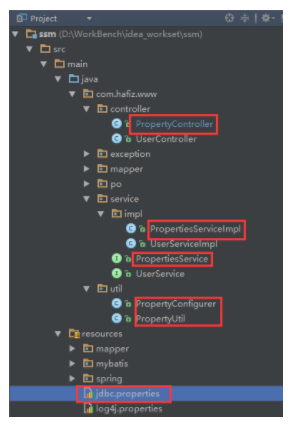一、背景
最近,在项目开发的过程中,遇到需要在properties文件中定义一些自定义的变量,以供java程序动态的读取,修改变量,不再需要修改代码的问题。就借此机会把Spring+SpringMVC+Mybatis整合开发的项目中通过java程序读取properties文件内容的方式进行了梳理和分析,现和大家共享。
二、项目环境介绍
Spring 4.2.6.RELEASE
SpringMvc 4.2.6.RELEASE
Mybatis 3.2.8
Maven 3.3.9
Jdk 1.7
Idea 15.04
三、五种实现方式
方式1.通过context:property-placeholder加载配置文件jdbc.properties中的内容
<context:property-placeholder location="classpath:jdbc.properties" ignore-unresolvable="true"/>
上面的配置和下面配置等价,是对下面配置的简化
<bean id="propertyConfigurer" class="org.springframework.beans.factory.config.PropertyPlaceholderConfigurer"> <property name="ignoreUnresolvablePlaceholders" value="true"/> <property name="locations"> <list> <value>classpath:jdbc.properties</value> </list> </property></bean>
注意:这种方式下,如果你在spring-mvc.xml文件中有如下配置,则一定不能缺少下面的红色部分,关于它的作用以及原理,参见另一篇博客:context:component-scan标签的use-default-filters属性的作用以及原理分析
<!-- 配置组件扫描,springmvc容器中只扫描Controller注解 --> <context:component-scan base-package="com.hafiz.www" use-default-filters="false"> <context:include-filter type="annotation" expression="org.springframework.stereotype.Controller"/> </context:component-scan>
方式2.使用注解的方式注入,主要用在java代码中使用注解注入properties文件中相应的value值
<bean id="prop" class="org.springframework.beans.factory.config.PropertiesFactoryBean"> <!-- 这里是PropertiesFactoryBean类,它也有个locations属性,也是接收一个数组,跟上面一样 --> <property name="locations"> <array> <value>classpath:jdbc.properties</value> </array> </property></bean>
方式3.使用util:properties标签进行暴露properties文件中的内容
<util:properties id="propertiesReader" location="classpath:jdbc.properties"/>
注意:使用上面这行配置,需要在spring-dao.xml文件的头部声明以下红色的部分
<beans xmlns="http://www.springframework.org/schema/beans" xmlns:xsi="http://www.w3.org/2001/XMLSchema-instance" xmlns:context="http://www.springframework.org/schema/context" xmlns:util="http://www.springframework.org/schema/util" xsi:schemaLocation="http://www.springframework.org/schema/beans http://www.springframework.org/schema/beans/spring-beans-3.2.xsd http://www.springframework.org/schema/context http://www.springframework.org/schema/context/spring-context-3.2.xsd http://www.springframework.org/schema/util http://www.springframework.org/schema/util/spring-util.xsd">
方式4.通过PropertyPlaceholderConfigurer在加载上下文的时候暴露properties到自定义子类的属性中以供程序中使用
<bean id="propertyConfigurer" class="com.hafiz.www.util.PropertyConfigurer"> <property name="ignoreUnresolvablePlaceholders" value="true"/> <property name="ignoreResourceNotFound" value="true"/> <property name="locations"> <list> <value>classpath:jdbc.properties</value> </list> </property></bean>
自定义类PropertyConfigurer的声明如下:
package com.hafiz.www.util;import org.springframework.beans.BeansException;import org.springframework.beans.factory.config.ConfigurableListableBeanFactory;import org.springframework.beans.factory.config.PropertyPlaceholderConfigurer;import java.util.Properties;/**
* Desc:properties配置文件读取类
* Created by hafiz.zhang on 2016/9/14. */public class PropertyConfigurer extends PropertyPlaceholderConfigurer { private Properties props; // 存取properties配置文件key-value结果
@Override protected void processProperties(ConfigurableListableBeanFactory beanFactoryToProcess, Properties props) throws BeansException { super.processProperties(beanFactoryToProcess, props); this.props = props;
} public String getProperty(String key){ return this.props.getProperty(key);
} public String getProperty(String key, String defaultValue) { return this.props.getProperty(key, defaultValue);
} public Object setProperty(String key, String value) { return this.props.setProperty(key, value);
}
}使用方式:在需要使用的类中使用@Autowired注解注入即可。
方式5.自定义工具类PropertyUtil,并在该类的static静态代码块中读取properties文件内容保存在static属性中以供别的程序使用
package com.hafiz.www.util;import org.slf4j.Logger;import org.slf4j.LoggerFactory;import java.io.*;import java.util.Properties;/**
* Desc:properties文件获取工具类
* Created by hafiz.zhang on 2016/9/15. */public class PropertyUtil { private static final Logger logger = LoggerFactory.getLogger(PropertyUtil.class); private static Properties props; static{
loadProps();
} synchronized static private void loadProps(){
logger.info("开始加载properties文件内容.......");
props = new Properties();
InputStream in = null; try {
<!--第一种,通过类加载器进行获取properties文件流-->
in = PropertyUtil.class.getClassLoader().getResourceAsStream("jdbc.properties");
<!--第二种,通过类进行获取properties文件流--> //in = PropertyUtil.class.getResourceAsStream("/jdbc.properties"); props.load(in);
} catch (FileNotFoundException e) {
logger.error("jdbc.properties文件未找到");
} catch (IOException e) {
logger.error("出现IOException");
} finally { try { if(null != in) {
in.close();
}
} catch (IOException e) {
logger.error("jdbc.properties文件流关闭出现异常");
}
}
logger.info("加载properties文件内容完成...........");
logger.info("properties文件内容:" + props);
} public static String getProperty(String key){ if(null == props) {
loadProps();
} return props.getProperty(key);
} public static String getProperty(String key, String defaultValue) { if(null == props) {
loadProps();
} return props.getProperty(key, defaultValue);
}
}说明:这样的话,在该类被加载的时候,它就会自动读取指定位置的配置文件内容并保存到静态属性中,高效且方便,一次加载,可多次使用。
四、注意事项及建议
以上五种方式,前三种方式比较死板,而且如果你想在带有@Controller注解的Bean中使用,你需要在SpringMVC的配置文件spring-mvc.xml中进行声明,如果你想在带有@Service、@Respository等非@Controller注解的Bean中进行使用,你需要在Spring的配置文件中spring.xml中进行声明。原因请参见另一篇博客:Spring和SpringMVC父子容器关系初窥
我个人比较建议第四种和第五种配置方式,第五种为最好,它连工具类对象都不需要注入,直接调用静态方法进行获取,而且只一次加载,效率也高。而且前三种方式都不是很灵活,需要修改@Value的键值。
五、测试验证是否可用
1.首先我们创建PropertiesService
package com.hafiz.www.service;/**
* Desc:java程序获取properties文件内容的service
* Created by hafiz.zhang on 2016/9/16. */public interface PropertiesService { /**
* 第一种实现方式获取properties文件中指定key的value
*
* @return
*/
String getProperyByFirstWay(); /**
* 第二种实现方式获取properties文件中指定key的value
*
* @return
*/
String getProperyBySecondWay(); /**
* 第三种实现方式获取properties文件中指定key的value
*
* @return
*/
String getProperyByThirdWay(); /**
* 第四种实现方式获取properties文件中指定key的value
*
* @param key
*
* @return
*/
String getProperyByFourthWay(String key); /**
* 第四种实现方式获取properties文件中指定key的value
*
* @param key
*
* @param defaultValue
*
* @return
*/
String getProperyByFourthWay(String key, String defaultValue); /**
* 第五种实现方式获取properties文件中指定key的value
*
* @param key
*
* @return
*/
String getProperyByFifthWay(String key); /**
* 第五种实现方式获取properties文件中指定key的value
*
* @param key
*
* @param defaultValue
*
* @return
*/
String getProperyByFifthWay(String key, String defaultValue);
}2.创建实现类PropertiesServiceImpl
package com.hafiz.www.service.impl;import com.hafiz.www.service.PropertiesService;import com.hafiz.www.util.PropertyConfigurer;import com.hafiz.www.util.PropertyUtil;import org.springframework.beans.factory.annotation.Autowired;import org.springframework.beans.factory.annotation.Value;import org.springframework.stereotype.Service;/**
* Desc:java程序获取properties文件内容的service的实现类
* Created by hafiz.zhang on 2016/9/16. */@Servicepublic class PropertiesServiceImpl implements PropertiesService {
@Value("${test}") private String testDataByFirst;
@Value("#{prop.test}") private String testDataBySecond;
@Value("#{propertiesReader[test]}") private String testDataByThird;
@Autowired private PropertyConfigurer pc;
@Override public String getProperyByFirstWay() { return testDataByFirst;
}
@Override public String getProperyBySecondWay() { return testDataBySecond;
}
@Override public String getProperyByThirdWay() { return testDataByThird;
}
@Override public String getProperyByFourthWay(String key) { return pc.getProperty(key);
}
@Override public String getProperyByFourthWay(String key, String defaultValue) { return pc.getProperty(key, defaultValue);
}
@Override public String getProperyByFifthWay(String key) { return PropertyUtil.getPropery(key);
}
@Override public String getProperyByFifthWay(String key, String defaultValue) { return PropertyUtil.getProperty(key, defaultValue);
}
}3.控制器类PropertyController
package com.hafiz.www.controller;import com.hafiz.www.service.PropertiesService;import com.hafiz.www.util.PropertyUtil;import org.springframework.beans.factory.annotation.Autowired;import org.springframework.stereotype.Controller;import org.springframework.web.bind.annotation.PathVariable;import org.springframework.web.bind.annotation.RequestMapping;import org.springframework.web.bind.annotation.RequestMethod;import org.springframework.web.bind.annotation.ResponseBody;/**
* Desc:properties测试控制器
* Created by hafiz.zhang on 2016/9/16. */@Controller
@RequestMapping("/prop")public class PropertyController {
@Autowired private PropertiesService ps;
@RequestMapping(value = "/way/first", method = RequestMethod.GET)
@ResponseBody public String getPropertyByFirstWay(){ return ps.getProperyByFirstWay();
}
@RequestMapping(value = "/way/second", method = RequestMethod.GET)
@ResponseBody public String getPropertyBySecondWay(){ return ps.getProperyBySecondWay();
}
@RequestMapping(value = "/way/third", method = RequestMethod.GET)
@ResponseBody public String getPropertyByThirdWay(){ return ps.getProperyByThirdWay();
}
@RequestMapping(value = "/way/fourth/{key}", method = RequestMethod.GET)
@ResponseBody public String getPropertyByFourthWay(@PathVariable("key") String key){ return ps.getProperyByFourthWay(key, "defaultValue");
}
@RequestMapping(value = "/way/fifth/{key}", method = RequestMethod.GET)
@ResponseBody public String getPropertyByFifthWay(@PathVariable("key") String key){ return PropertyUtil.getProperty(key, "defaultValue");
}
}4.jdbc.properties文件
jdbc.driver=com.mysql.jdbc.Driver jdbc.url=jdbc:mysql://192.168.1.196:3306/dev?useUnicode=true&characterEncoding=UTF-8jdbc.username=root jdbc.password=123456jdbc.maxActive=200jdbc.minIdle=5jdbc.initialSize=1jdbc.maxWait=60000jdbc.timeBetweenEvictionRunsMillis=60000jdbc.minEvictableIdleTimeMillis=300000jdbc.validationQuery=select 1 from t_user jdbc.testWhileIdle=truejdbc.testOnReturn=falsejdbc.poolPreparedStatements=truejdbc.maxPoolPreparedStatementPerConnectionSize=20jdbc.filters=stat #test data test=com.hafiz.www
5.项目结果图

6.项目GitHub地址
https://github.com/hafizzhang/SSM/branches 页面下的propertiesConfigurer分支。
7.测试结果
第一种方式

第二种方式

第三种方式

第四种方式

第五种方式

六、总结
通过本次的梳理和测试,我们理解了Spring和SpringMVC的父子容器关系以及context:component-scan标签包扫描时最容易忽略的use-default-filters属性的作用以及原理。能够更好地定位和快速解决再遇到的问题。总之,棒棒哒~~~
感谢您花时间阅读此篇文章,如果您觉得这篇文章你学到了东西也是为了犒劳下博主的码字不易不妨打赏一下吧,让博主能喝上一杯咖啡,在此谢过了!
如果您觉得阅读本文对您有帮助,请点一下左下角“推荐”按钮,您的将是我最大的写作动力!另外您也可以选择【关注我】,可以很方便找到我!
共同学习,写下你的评论
暂无评论
作者其他优质文章





